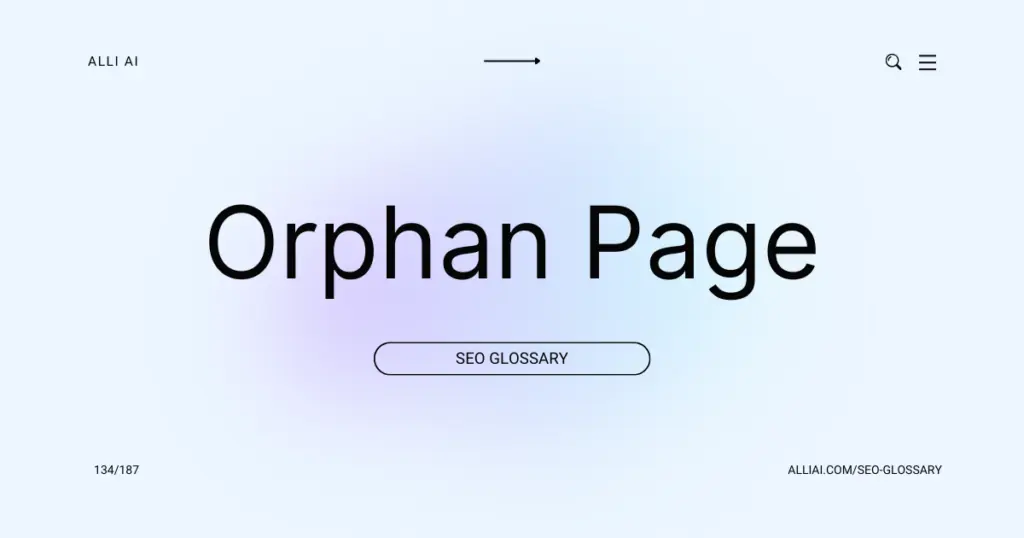What Does Orphan Page Mean?
An orphan page is a webpage that is not linked from any other page on the same website. This means it is isolated or ‘orphaned,’ making it hard for both users and search engines to find it.
Where Does Orphan Page Fit Into The Broader SEO Landscape?
An orphan page is a webpage that has no incoming links from other pages within the same website, making it inaccessible through internal navigation. In SEO, orphan pages are significant because they often go unnoticed by search engines, since crawlers typically discover new pages through links. Without links, these pages might not be indexed or ranked, reducing the overall effectiveness of the website’s SEO strategy. Addressing orphan pages by properly linking them within the site structure can enhance site navigation, improve user experience, and ensure that all valuable content has the potential to rank in search engine results, thereby bolstering the site’s SEO performance.
Real Life Analogies or Metaphors to Explain Orphan Page
An orphan page on a website is like a room in a house with no doors; even though it exists and may be fully furnished, visitors can’t enter it because there are no pathways leading to it.
How the Orphan Page Functions or is Implemented?
1. Definition of Orphan Page: An orphan page is a webpage that has no incoming links from other pages within the same website. It is not accessible through the internal navigation of the website.
2. Creation: Orphan pages are often created unintentionally during website redesigns, content updates, or through oversight when older pages are disconnected from the website’s structure.
3. Identification: To identify orphan pages:
– Use a crawler tool like Screaming Frog, Xenu, or Ahrefs to crawl the entire website.
– Compare the list of URLs found by the crawler with the list of URLs accessible through the site’s internal linking using a sitemap or manual inventory.
– URLs that appear in the crawler but not in the internal link analysis are potential orphan pages.
4. Review: After identifying orphan pages, each page should be reviewed to decide if it should be reintegrated into the website or removed. Factors to consider include the relevance of the content, current SEO value, and whether the content duplicates information available on other pages.
5. Reintegration: To reintegrate an orphan page, decide where it fits into the website’s structure:
– Identify relevant parent pages or categories for integration.
– Add internal links from relevant pages and navigation elements to the orphan page.
– Ensure it adheres to the overall informational architecture of the site.
6. Deletion: If an orphan page is outdated, irrelevant, or redundant, it should be deleted:
– Remove the page from the server.
– Ensure that any external links to the page are redirected to relevant pages to maintain link equity and improve user experience.
7. Prevention: Prevent future occurrences of orphan pages:
– Establish protocols for regularly auditing the site’s structure and internal links.
– Ensure all new pages are adequately linked from existing pages.
– Maintain an updated sitemap and link structure as part of the website management routine.
Impact Orphan Page has on SEO
Isolation from the site’s internal link structure has several detrimental effects on SEO performance, rankings, and user experience:
1) Invisibility to Search Engines: Orphan pages are typically not discovered by search engine crawlers. Without internal links leading to them, these pages rely solely on direct URLs being indexed, which is an unreliable and inconsistent method. Consequently, they often remain unindexed, meaning they do not appear in search results, which negates their potential contribution to the site’s overall SEO.
2) Wasted Content: From an SEO perspective, every page on a website should ideally contribute to its authority and relevance. Orphan pages, being isolated, do not contribute to the domain’s authority or help other pages rank better through internal linking, thus wasting potential content.
3) User Navigation Challenges: For users who somehow find an orphan page (e.g., through a direct link), the lack of internal links can result in a poor navigational experience. Users may find it difficult to explore related content or even return to previously visited pages, leading to frustration and a higher likelihood of exiting the site.
4) Impact on Site Architecture: Effective site architecture relies on a logical hierarchy and linking structure that helps search engines understand the relative importance and relationship between pages. Orphan pages disrupt this structure, creating pockets of disconnected content, which can diminish the overall readability and perceived quality of the site by search engines.
5) Missed Conversion Opportunities: Orphan pages are often not optimized for conversions since they do not support the user journey across the site. Without links guiding users to conversion-focused pages or further engaging content, these pages can result in missed opportunities for lead generation and sales.
SEO Best Practices For Orphan Page
1. Identify all orphan pages on your website using a site crawler tool like Screaming Frog or SEMrush.
2. Evaluate the content of the orphan page to determine its relevance to your overall website content and SEO strategy.
3. Decide if the orphan page should be integrated into the website’s structure or removed. If it is valuable, proceed with integration.
4. Create logical pathways to the orphan page by linking to it from relevant main pages, such as your homepage or category pages. Ensure the anchor text used in links is relevant to the target page’s content.
5. Add the orphan page to your site’s XML sitemap to ensure search engines can find and index it.
6. Utilize internal linking by adding links from the orphan page to other relevant pages within your site to facilitate site navigation and improve SEO.
7. Update the orphan page’s content to ensure it is high-quality, relevant, and utilizes targeted keywords effectively.
8. Optimize on-page elements such as the title tag, meta description, header tags, and images with appropriate and relevant keywords.
9. Make sure the orphan page is mobile-friendly and loads quickly by optimizing images, leveraging browser caching, and minimizing CSS and JavaScript.
10. Finally, track the performance of the orphan page in terms of traffic and rankings, using tools like Google Analytics and Google Search Console, and adjust your strategy as necessary.
Common Mistakes To Avoid
1. Lack of Internal Links: Without internal links leading to the orphan page, it becomes disconnected from the website’s main structure. To avoid this, regularly audit your site’s link structure and ensure all important pages are integrated smoothly into the website’s navigation.
2. Search Engines Can’t Index: Orphan pages are unlikely to be indexed by search engines since they have no internal links pointing to them. Ensure every page is accessible via at least one other internal page.
3. Missed Conversion Opportunities: Orphan pages that could potentially convert visitors are wasted if they aren’t found. Link to these pages from relevant parts of your site to facilitate visitor traffic and increase conversion potential.
4. Waste of Resources: Creating content that remains unseen uses up resources without return. Use sitemaps and regular content reviews to maintain visibility and utility of all pages.
5. Poor User Experience: Users might stumble upon an orphan page without context, leading to confusion. Make sure all pages provide navigational cues and are part of a coherent user journey.
6. Ineffective Content Updates: If orphan pages remain unchecked, they may contain outdated information, which can be harmful if discovered by users. Regularly schedule content audits to update or remove obsolete pages.
7. SEO Penalties: Orphan pages can appear as low-quality content to search engines, potentially impacting your site’s overall SEO performance. Ensure that each page has a clear purpose, is well-linked, and contains quality content.
8. Inconsistent Branding: Orphan pages often lack consistent branding or design, leading to a disjointed brand image. Regularly review all pages for brand consistency.
9. Difficulty in Tracking Performance: It’s challenging to track the effectiveness of an orphan page without traffic. Implement tracking like Google Analytics on all pages and use the data to make informed decisions about page modifications or deletions.
10. Neglecting Page Potential: Many orphan pages might actually serve a valuable niche if properly integrated and promoted within the site. Evaluate the potential of all content and strategically link to high-value orphan pages from relevant sections of your site.






